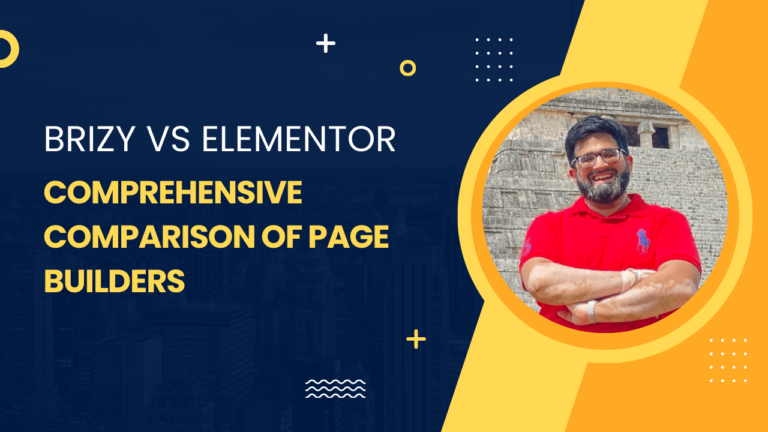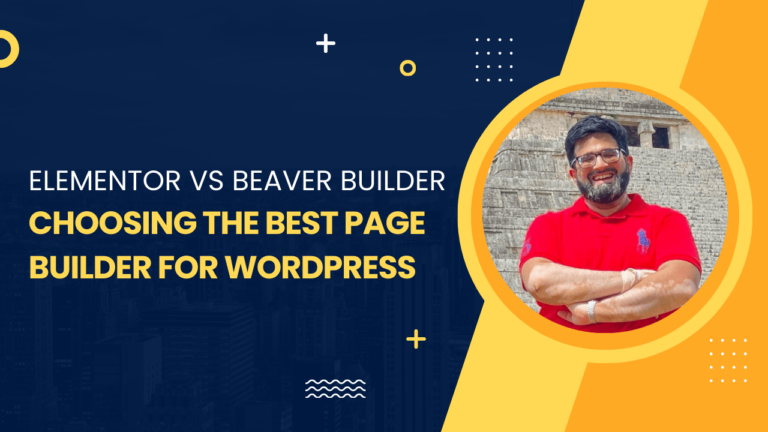Gutenberg vs Elementor: The best WordPress Builder
When you’re building your WordPress site, choosing the right page builder is crucial. Gutenberg vs Elementor both are two prominent tools you’ll encounter. Gutenberg is the default block editor introduced in WordPress 5.0. It operates directly within the WordPress interface and emphasizes simplicity and page speed.
Gutenberg:
- Block Editor: Optimized for direct integration with WordPress.
- Performance: Fast and efficient, with a focus on ease of use through block manipulation.
- Compatibility: Works well with most WordPress themes and plugins.
Elementor:
- Page Builder: It’s a powerful third-party plugin that extends WordPress capabilities.
- User Experience: Provides a seamless drag-and-drop interface, offering advanced design options.
- Features: Comes with a broad assortment of widgets and templates, allowing for extensive customization beyond standard WordPress functionality.
When comparing the two, you’ll find that Elementor caters to those who seek a more comprehensive design experience, without depending on additional themes or plugins. In contrast, Gutenberg delivers a straightforward approach, maintaining a clean and efficient workflow within the WordPress ecosystem.
Here’s a quick side-by-side:
| Feature | Gutenberg | Elementor |
|---|---|---|
| Type | Block editor | Page builder |
| Integration | Native WordPress experience | Third-party plugin |
| Customization | Basic but enhancing | Extensive and feature-rich |
| Learning Curve | Lower | Higher, depending on complexity |
| Speed | Generally faster | Varies based on design elements |
Your choice between Gutenberg and Elementor will fundamentally depend on your preferred workflow, the level of customization you desire, and your technical expertise. Each tool brings its distinct advantages to the table.
User Experience and Interface
When evaluating the user experience between the Gutenberg editor and the Elementor plugin, your interactions with these tools are paramount. Gutenberg’s interface is integrated directly within WordPress, providing a more native editing experience. You’ll find it relies on a system of blocks, which are the fundamental elements of your content layout. Each block represents a different type of content, allowing you to build your pages piece by piece.
In contrast, Elementor offers a distinct drag-and-drop interface. This potentially reduces the time it takes for you to start creating complex layouts. The interface is designed to be intuitive, with a visual preview of your design as you work. Widgets, which serve as the building blocks in Elementor, are versatile and offer advanced design options.
| Feature | Gutenberg | Elementor |
|---|---|---|
| Interface Type | Block-based | Drag-and-drop |
| Learning Curve | Moderate | Steeper due to advanced features |
| Design Flexibility | Limited to blocks | Extensive with widgets and templates |
| Integration | Native with WordPress | Third-party plugin |
You may find Gutenberg’s user interface less overwhelming initially, due to its simplicity and focus on content creation. The learning curve here is generally more modest. However, transitioning to Elementor could involve a steeper learning curve, as it offers more sophisticated design capabilities.
When choosing between the two, your decision may hinge on the balance between ease of use and design flexibility. If your priority is simplicity and a content-focused layout, Gutenberg’s blocks could be sufficient. However, for more intricate designs and a robust interactive interface, Elementor’s widgets and drag-and-drop functionality are compelling features to consider.
Core Features and Capabilities
Comparing Gutenberg and Elementor, you’ll find distinct tools with unique features and abilities. Each offers a diverse range of options for building and customizing your WordPress website, from the basic construction elements to advanced functionalities and pre-designed layouts.
Gutenberg Blocks and Editor
Gutenberg, the default WordPress editor, organizes your content into blocks. These blocks include various elements such as text, images, and headers. You have a straightforward interface that allows you to manage the layout of your content with blocks that cover everything from paragraphs and galleries to more complex patterns.
Elementor Widgets and Editor
On the other hand, Elementor provides a drag-and-drop editor and a wide array of widgets. These cover basic elements like images and text, as well as advanced elements such as testimonials, counters, and progress bars. The real-time preview ensures that you see the changes as you make them, enhancing the ease of customization options.
Advanced Functionalities
Elementor excels in advanced functionalities, including a theme builder for complete theme designs, a pop-up builder for engaging user interactions, and comprehensive tools for ecommerce and responsive design. Elementor also allows for custom CSS, giving you more control over the style.
Customization and Flexibility
When examining customization and flexibility, Elementor generally offers more options with its drag-and-drop functionality, enabling extensive customization without the need for coding. Gutenberg’s customization options are evolving but still rely on themes and plugins to extend its capabilities.
Add-ons and Plugins
Both Gutenberg and Elementor support a variety of add-ons and plugins. Elementor has a vast ecosystem of third-party addons that extend its functionality even further. Gutenberg’s capabilities can also be expanded with blocks and layout plugins, leveraging the WordPress plugin directory.
Templates and Pre-Designed Layouts
Templates are a significant time saver in website building. Elementor provides a rich library of templates and sections that you can insert and adapt as needed. Gutenberg offers patterns, which are pre-designed sections of blocks, but the library isn’t as extensive as Elementor’s.
By choosing the tool that aligns with your website-building needs and skill level, whether it’s Gutenberg’s block-based approach or Elementor’s widget-rich environment, you equip yourself with the necessary functionalities to create and customize your site effectively.
Usability for Different User Roles
When considering Gutenberg and Elementor, your focus should be on how each tool fits various user roles, from beginners to seasoned developers, and how they align with different WordPress community requirements and content management processes.
Ease of Use for Beginners
Gutenberg: As a beginner, you’ll find Gutenberg’s interface welcoming because it’s a part of the WordPress core, meaning no additional plugins are necessary. It relies on a block editor that is rather intuitive, reducing the learning curve and simplifying your initial forays into content creation.
Elementor: For those new to WordPress, Elementor provides a drag-and-drop page builder, which may offer a more visually straightforward way of building pages. Its stand-alone interface can be more user-friendly, but it’s a separate system to understand on top of WordPress basics.
Toolset for Developers and Designers
For developers and designers, the mention of coding in HTML and CSS might bring different reactions depending on the tool you’re working with.
Gutenberg:
- Offers basic blocks out of the box for simpler designs.
- Allows the addition of custom blocks with knowledge of HTML, CSS, and JavaScript, catering to developers who want to extend the editor’s functionality.
Elementor:
- Provides a comprehensive suite of elements for complex designs.
- Supports coding custom widgets and sections, appealing to experts who appreciate the ability to implement detailed customizations.
WordPress Community and Support
Gutenberg: Being an integral part of WordPress, Gutenberg benefits from the extensive support and resources of the WordPress community. You’ll find a host of tutorials, forums, and documentation available for troubleshooting and learning.
Elementor: Although separate from WordPress’s default systems, Elementor has built a strong community with abundant resources for learning and problem-solving. Their dedicated support is known for being effective and helpful to users at all levels.
Content Management and Editing Workflow
Considering the workflow between posts and pages or building a web page, your experience will vary with each editor.
Gutenberg:
- Streamlines the process of managing content directly within the WordPress dashboard.
- Offers an efficient method for editing text content and a simple interface that does not require switching between different views for posts and pages.
Elementor:
- Provides an advanced interface that separates the page-building workflow from the default WordPress environment.
- May enhance user experience for those who prioritize visual design and layout controls in the page-building process.
Your choice between Gutenberg and Elementor should reflect your personal preference for interface interaction, the complexity of web design you aspire to, and the type of content management workflow you prefer.
Integration and Compatibility
When choosing between Gutenberg and Elementor, understanding how each WordPress page builder integrates with other plugins and themes is essential for your website’s performance and functionality. Gutenberg is WordPress’s default editor, providing native compatibility with most WordPress themes and plugins, including WooCommerce. This ensures a high level of consistency and stability across a wide array of WordPress tools.
Gutenberg:
- Compatibility: Native integration with WordPress core
- WooCommerce: Direct support for WooCommerce plugins
- Themes: Works with almost any WordPress theme
Elementor, as a third-party plugin, offers an extensive marketplace of widgets and features. Elementor has been designed to provide seamless integration with a large selection of WordPress themes and plugins; however, being a third-party solution, it might occasionally encounter compatibility issues that require additional troubleshooting or support.
Elementor:
- Widgets: A vast range of custom widgets available
- Compatibility: Widely compatible with themes and plugins
- WooCommerce: Supports WooCommerce with specialized widgets
In terms of page building, both Gutenberg and Elementor ensure that your ability to edit and customize is paired with a commitment to compatibility. Elementor presents you with a more extensive ecosystem for integrations, but Gutenberg’s alignment with the WordPress core translates into inherent compatibility advantages. Your choice should be informed by the specific requirements of your project and your comfort with potentially needing to resolve compatibility challenges that may arise with third-party plugins.
Performance and Impact on Website
Selecting the right page builder for your WordPress site will significantly affect performance and the overall impact on your website. These factors are crucial for maintaining a fast-loading, responsive site that ranks well and stays compatible with ongoing WordPress updates.
Page Speed and Load Times
When you prioritize page speed and load times, you’re ensuring a better user experience. Elementor’s drag-and-drop features might add extra code, which could potentially slow down your page. On the other hand, Gutenberg, as a more streamlined editor, introduces less code overhead, leading generally to faster load times. Always check the page size after building it, as this directly affects website speed.
- Elementor: May increase page size, impacting page speed
- Gutenberg: Tends to keep page size down, preserving website speed
Responsiveness and Cross-Device Compatibility
Your site’s responsive design is key to engaging users across all devices. With Elementor, you get responsive editing controls, enabling you to adjust settings for various screen sizes, ensuring that your site is mobile-friendly. Gutenberg offers responsive design capabilities natively, which aligns well with themes and can be extended for greater control.
- Elementor: Advanced responsive editing options
- Gutenberg: Built-in responsive design that’s extendable with plugins
SEO and Website Visibility
For SEO and visibility, how your content is structured and loaded impacts your ranking. Elementor’s design flexibility allows for engaging elements that can increase user interaction, while Gutenberg offers a cleaner code structure that may be favored by search engines.
- Elementor: Engaging elements can improve interaction signals for SEO
- Gutenberg: Cleaner code might align better with search engine preferences
Compatibility with WordPress Updates
Compatibility with WordPress updates can affect your website’s longevity. Elementor must regularly adapt to changes, which can sometimes introduce compatibility issues. Gutenberg is part of the WordPress core, so it’s inherently compatible with updates, reducing the risk of issues after an update.
- Elementor: Potential compatibility issues with updates, requiring patches
- Gutenberg: Inherent compatibility, staying abreast of core updates
Pricing and Versions
When evaluating Elementor and Gutenberg for your WordPress website, understanding their pricing and versions is crucial.
Gutenberg is built directly into WordPress and is entirely free. You don’t have to pay to use its features. However, it’s important to note that, being free, you’ll generally rely on community support or your host’s resources should you encounter any issues.
- Gutenberg:
- Price: Free
- Version: Integrated with WordPress
- Support: Community-based
In contrast, Elementor offers both a free and a pro version. The free version includes numerous tools that may suffice for basic web building needs. If you require more advanced features like additional widgets and customization options, their premium plans come into play.
- Elementor:
- Free Version: Adequate for basic needs with essential tools.
- Pro Version: Includes advanced features and premium support.
Here’s a summary of what to expect cost-wise for Elementor’s Pro Version:
| Elementor Pro Version | Annual Pricing |
|---|---|
| Personal | $49 for 1 Site |
| Plus | $99 for 3 Sites |
| Expert | $199 for 25 Sites |
Remember that these costs are subject to change and special discounts may occasionally be available. It is always best to check the official Elementor website for the latest pricing information.
When deciding between Gutenberg and Elementor, consider your budget and the complexity of your project. If cost is a limiting factor, Gutenberg’s zero price tag is appealing. If you need more sophisticated design capabilities, Elementor’s free version may be a starting point, with the option to upgrade to Pro if necessary.
Elementor and Gutenberg Comparison
In the realm of page building for WordPress, you have two prominent choices: Elementor and Gutenberg. These tools each offer distinct approaches to creating and managing content on your website. Exploring their user interfaces and features will help you discern which may suit your workflow and needs better.
User Interface Contrast
Gutenberg presents a block-based editor that is integrated into WordPress core as its default page builder. Its interface is minimalistic and focuses on a streamlined editing experience. As you craft your content, you’ll interact with Gutenberg blocks, which act as individual content elements that you can insert and arrange with ease.
| Gutenberg | Elementor | |
|---|---|---|
| Focus | Streamlined editing, less complexity | Rich editing, high customizability |
| Layout | Blocks arranged within the post editor | Sections and columns framework |
| Editing | Inline text and block-sidebar settings | Popup editors and inline settings |
| Ease of Use | Friendly for beginners due to simplicity | Intuitive, but might have a steeper learning curve |
In contrast, Elementor’s user interface is more advanced, displaying a side panel where you adjust the properties of Elementor widgets. These widgets are akin to Gutenberg blocks but offer more granular control over their appearance and behavior.
Features and Functionality Divergence
When examining the features and functionality, the divergence between Gutenberg and Elementor becomes more evident. Gutenberg’s offering is inherently tied to WordPress and tends to be more restrained but steadily growing with each update. The editor provides basic functionality that may be sufficient if your demands are straightforward.
Gutenberg Features:
- Simplified content creation with blocks
- Direct integration with WordPress core and themes
- Quick to learn with a focus on writing and editing content
Elementor, being a plugin, extends beyond content arrangement to provide a rich set of features that enable in-depth customization of every page element. This includes a wide array of Elementor widgets designed for intricate designs and functionality that Gutenberg doesn’t inherently support.
Elementor Features:
- Advanced design options with pixel-perfect customization
- A plethora of widgets for added functionality
- Responsiveness controls for various device views
- Dynamic content and template functionality
Your choice will hinge upon your specific requirements: If you favor simplicity and default WordPress integration, Gutenberg may be your preference, but if you seek depth in design and functionality, Elementor is likely the more fitting option.
Conclusion and Recommendations
When deciding between Gutenberg and Elementor for your WordPress website, consider your needs and expertise level. Gutenberg is the default editor in WordPress, providing a basic, block-based way to create and manage content. It might be suitable if your site has simpler design requirements.
Gutenberg:
- Integrated into WordPress
- Basic block-based editing
- Better performance in some cases
- Suitable for simple editing needs
Elementor:
- Third-party plugin, more complex
- Advanced drag-and-drop interface
- Potentially slower page load times
- Comprehensive design options
If you require advanced design capabilities and have some experience with website building, Elementor could be your preferred choice. It offers extensive customization options that allow you to craft a more personalized and intricate website design.
Your choice should align with your project goals:
- For ease of use and performance: Opt for Gutenberg.
- For customization and design flexibility: Choose Elementor.
Remember to weigh the importance of community support and future scalability when making your decision. Both Gutenberg and Elementor have strong communities, but Elementor’s might provide more dedicated design resources given its nature as a feature-rich page builder.
In summary, select Gutenberg for a streamlined, straightforward building experience, or go with Elementor if you need a more robust, feature-laden toolset for your website design needs. Your decision should be informed by the complexity of your project and your comfort with the tools at hand.
Entity Coverage
When it comes to building your WordPress site, you might be comparing Elementor and Gutenberg. These two entities offer different approaches and capabilities that cater to various needs and preferences.
Elementor:
- Page Builder Plugin: It’s a comprehensive WordPress page builder known for its drag-and-drop interface.
- Templates: Offers an extensive library with a wide range of templates and blocks.
- Ease of Use: Generally considered user-friendly with a shorter learning curve.
- Customization: Provides in-depth customization options, including widgets, headers, and other dynamic content elements.
- Pricing: Available in both a free version and a pro version, with added features and addons.
- Expert Level: Suits both beginners and developers as it offers advanced features without requiring knowledge of HTML/CSS.
- Compatibility: Works with most WordPress themes, but best with themes specifically optimized for it.
Gutenberg:
- Block Editor: Integrated within WordPress as the default content editor.
- Gutenberg Blocks: Uses blocks to create content, which can be enhanced with third-party plugins.
- Learning Curve: May require a bit more time to master compared to traditional WYSIWYG editors.
- Flexibility: Offers more native compatibility with WordPress, aligning with the future development of the WordPress core.
- Performance: Less likely to impact page speed and website performance due to being more lightweight.
- Expert Level: Ideal for users who are comfortable with WordPress and prefer sticking with the classic editor feel.
- Free Version: No premium version; it’s entirely free as part of the WordPress core.
In summary, your choice between Elementor and Gutenberg will depend on your specific needs. Elementor excels in user-friendliness and extensive customization options, whereas Gutenberg offers a more streamlined, core WordPress experience with solid performance and improved compatibility with future updates. Consider your level of expertise, desired website functionality, layout complexity, and whether you’re aiming for a site with standard content or a highly customizable web presence.
Frequently Asked Questions
In this section, we address some of the common questions you might have about choosing between Elementor and Gutenberg for your WordPress site.
What are the advantages of using Elementor over Gutenberg?
Elementor offers a more extensive set of design options and widgets out of the box, giving you more flexibility to create complex layouts without needing to know how to code. It’s particularly popular for its intuitive drag-and-drop interface.
In terms of performance, which is better: Gutenberg or Elementor?
Gutenberg generally performs faster than Elementor because it is less resource-intensive. Elementor’s advanced features can slow down page loading times if not optimized properly.
How do Gutenberg and Elementor compare when it comes to ease of use for beginners?
Gutenberg provides a more straightforward experience for beginners, with a focus on content creation using blocks. Elementor, while also user-friendly, has a steeper learning curve due to its more extensive feature set.
Can Elementor and Gutenberg be used in conjunction on the same WordPress site?
Yes, Elementor and Gutenberg can be used together on a WordPress site. You can switch between them for different pages or posts, using Gutenberg for simpler layouts and Elementor for more complex designs.
What are the limitations of the Gutenberg editor compared to premium page builders like Elementor?
Gutenberg’s editor is limited in its design capabilities and lacks the breadth of widgets and style options provided by Elementor. Advanced styling and layout features in Gutenberg may require additional plugins or custom code.
How do updates and support compare between Gutenberg and Elementor?
Gutenberg, as part of WordPress core, receives regular updates and has a large community for support. Elementor offers its own support channels and regular updates, with premium support available for its Pro version.






